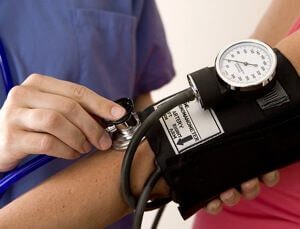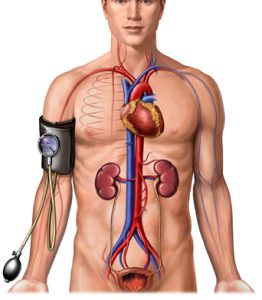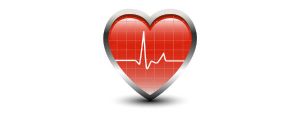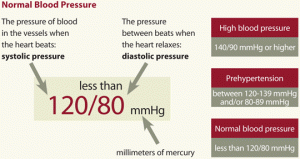Is Your High Blood Pressure Reading due to Bad Measurement Technique?
Is Your High Blood Pressure Reading due to Bad Measurement Technique?
Was your high blood pressure based on an accurate measurement? It is surprising how frequently something as fundamental as blood pressure is measured wrong.
Joe Graedon December 26, 2016 Drug Side Effects 2 Comments
One of the most fundamental measurements that is taken at almost every doctor’s visit is blood pressure. After you get weighed, a nurse frequently will check to see whether your blood pressure is within the “normal” limits. Not infrequently, blood pressure measurements are taken incorrectly as this reader reports:
Q. I recently had a doctor’s appointment and the nurse measured my blood pressure while I was sitting on the exam table with my arm dangling at my side. It was 153 over 95 and that was entered into my chart. At home it was 135 over 82.
The doctor is talking about starting me on a diuretic to lower my high blood pressure. I’m not convinced I really need it.
A. Proper blood pressure measurement requires the patient to be seated in a chair with back support and both feet on the floor. The arm should be supported at heart level, the cuff should be the right size and there should be no talking. Otherwise, the reading could be inaccurate.
What’s the Big Deal?
When a blood pressure reading is falsely elevated either because the cuff is the wrong size or your arm is in the wrong position, you could be falsely diagnosed as hypertensive. That can set in motion a domino effect.
First, you are labeled with a chronic condition: high blood pressure or hypertension. That can affect life insurance, health insurance and employment. It also affects sense of self. You are now no longer “normal.” A diagnosis of high blood pressure can also lead to medication, with potential side effects.
Cuff Size:
Let’s just take cuff size, for example. If you have a large arm, a cuff that is too small can falsely elevate blood pressure. When was the last time someone actually measured your arm to see if it required a larger cuff? Did the nurse have a larger cuff available. And by the way, a very thin arm should not be measured with a standard sized cuff either. That could lead to an inaccurate reading.
Do NOT Talk!
Talking while your blood pressure is being taken can increase the reading by 10 to 20 points. If the nurse ask you something personal or emotional, the reading could go even higher (Angiology, July, 1982). This is not something most health professionals are aware of.
Reader Stories about High Blood Pressure & Faulty Measurements:
This report came from D.B.
“Just after I entered menopause, my doctor felt I had high blood pressure – even though readings were taken incorrectly. (I was having lots of trouble sleeping at the time.) She put me on a diuretic called HCTZ. After a couple of days, I was feeling really awful. Dizzy, nauseated, shaky, no energy. After four days, my heart was racing – 120 beats/minute – and I was just relaxing in a recliner reading the newspaper.
“I called to report the side effects and was told by the nurse that these side effects were not listed under this medication. I let her know that they were listed in the info I got from the pharmacy.
“After talking with the doctor, the nurse said they’d switch me to a Beta Blocker, until I reminded her that I have asthma – so a Beta Blocker would not be a good idea for me! I think my electrolytes were completely out of balance. No one ever suggested a smaller dose or anything else.
“I recently worked with a functional medicine (FM) practitioner to figure out why I couldn’t lose weight and was still very fatigued. Since then I have lost about 25 pounds of fat and have healed my esophagus of Barrett’s and healed SIBO and have lots less inflammation, and guess what! My blood pressure is much better. Funny, though, the FM practitioner never takes my blood pressure the same way twice and often does it incorrectly, too! I still take my own blood pressure at home a couple times a week, just to keep my eye on it.”
Louis in Florida makes a good point:
“In addition to no talking, I have found that no body movement-head, arms, legs or shifting around will result in a most accurate reading, whether at home or in the doctor’s office.
Differences of 10 to 40 points higher occur with movement.”
Nurse Carol reports her own experience:
“I always take my BP at home for the week prior to my doctor visit and give her the readings. As a registered nurse, I am appalled by what I see when the assistants take BP’s. You are sitting on the end of the exam table with your legs dangling and your arm is hanging down.
“They also never seem to put the cuff on tight enough to pick up an accurate reading. My brachial pulse is difficult to palpate so the cuff needs to be snug to pick up the pulse. I have had readings of 180/110 with the cuff is not even touching my skin but when the cuff is on snug the reading comes down to 120/80. The assistants also don’t allow for a 10 minute rest period after escorting you to the exam room. I bet over half of people on drugs for hypertension have normal blood pressure.”
Anyone who would like to learn more about proper blood pressure measurement techniques and ways to control hypertension with and without drugs may find our Guide to Blood Pressure Treatment of interest.
Blood Pressure UK is the only charity solely dedicated to lowering the nation’s blood pressure to prevent disability and death from stroke and heart disease.
Our vision is that everyone will know their blood pressure numbers, in the same way that they know their height or weight, and take steps to keep them healthy both now and in the future.
What is blood pressure?
When your heart beats, it pumps blood round your body to give it the energy and oxygen it needs. As the blood moves, it pushes against the sides of the blood vessels. The strength of this pushing is your blood pressure. If your blood pressure is too high, it puts extra strain on your arteries (and your heart) and this may lead to heart attacks and strokes.
How you can tell if you have high blood pressure?
Having high blood pressure (hypertension) is not usually something that you feel or notice. It does not tend to produce obvious signs or symptoms. The only way to know what your blood pressure is, is to have it measured.
Blood pressure is measured in ‘millimetres of mercury’ (mmHg) and is written as two numbers. For example, if your reading is 120/80mmHg, your blood pressure is ‘120 over 80’.
What do the numbers mean?
Every blood pressure reading consists of two numbers or levels. They are shown as one number on top of the other.
The first (or top) number is your systolic blood pressure. It is the highest level your blood pressure reaches when your heart beats.
The second (or bottom) number is your diastolic blood pressure. It is the lowest level your blood pressure reaches as your heart relaxes between beats.
Blood pressure readings explained
Keep your blood pressure low
Even if you do not have high blood pressure at the moment, it is important to keep your blood pressure as low as you can. The higher your blood pressure, the higher your risk of health problems.
For example, a blood pressure of 135 over 85 may be “normal” but someone with this reading is twice as likely to have a heart attack or stroke as someone with a reading of 115 over 75.
Blood pressure chart
Use the blood pressure chart below to see what your blood pressure means. The blood pressure chart is suitable for adults of any age. (The level for high blood pressure does not change with age.)
Blood pressure readings have two numbers, for example 140/90mmHg.
The top number is your systolic blood pressure. (The highest pressure when your heart beats and pushes the blood round your body.) The bottom one is your diastolic blood pressure. (The lowest pressure when your heart relaxes between beats.)
The blood pressure chart below shows ranges of high, low and healthy blood pressure readings.
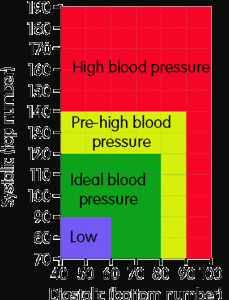
Blood pressure chart for adults
Using this blood pressure chart:
To work out what your blood pressure readings mean, just find your top number (systolic) on the left side of the blood pressure chart and read across, and your bottom number (diastolic) on the bottom of the blood pressure chart. Where the two meet is your blood pressure.
Download the Blood Pressure Chart
Download the Blood Pressure Chart(123.96 Kb)
What blood pressure readings mean
As you can see from the blood pressure chart, only one of the numbers has to be higher or lower than it should be to count as either high blood pressure or low blood pressure:
- 90 over 60 (90/60) or less: You may have low blood pressure. More on low blood pressure.
- More than 90 over 60 (90/60) and less than 120 over 80 (120/80): Your blood pressure reading is ideal and healthy. Follow a healthy lifestyle to keep it at this level.
- More than 120 over 80 and less than 140 over 90 (120/80-140/90): You have a normal blood pressure reading but it is a little higher than it should be, and you should try to lower it. Make healthy changes to your lifestyle.
- 140 over 90 (140/90) or higher (over a number of weeks): You may have high blood pressure (hypertension). Change your lifestyle – see your doctor or nurse and take any medicines they may give you. More on high blood pressure
So:
- if your top number is 140 or more – then you may have high blood pressure, regardless of your bottom number.
- if your bottom number is 90 or more – then you may have high blood pressure, regardless your top number.
- if your top number is 90 or less – then you may have low blood pressure, regardless of your bottom number.
- if your bottom number is 60 or less – then you may have low blood pressure, regardless of your top number.
More on blood pressure:
- What is blood pressure?
- What is normal blood pressure?
- What is high blood pressure?
- What is low blood pressure?
- What high blood pressure can do
- How to lower your blood pressure
- High blood pressure medication
- Home blood pressure monitoring
- Understanding high blood pressure DVD
For further information or advice:
Please phone: 020 7882 6218
Or email: help@bloodpressureuk.org
Or write to us at: Blood Pressure UK Helpline, Wolfson Institute of Preventive Medicine, Charterhouse Square, London, EC1M 6BQ.
The helpline is managed on a part time basis, please leave a message and your call will be returned by one of our healthcare team.
If your call is urgent, or you think you may be having a stroke or heart attack – please call 999 immediately.


